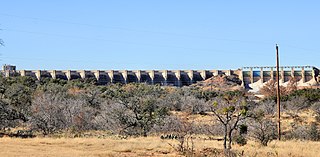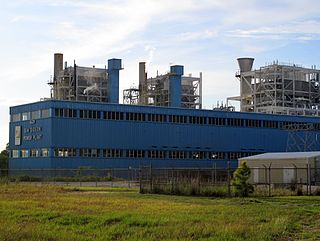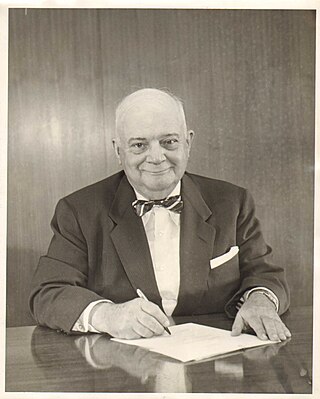
Lake Travis is a reservoir on the Colorado River in central Texas in the United States.

Lake Austin, formerly Lake McDonald, is a water reservoir on the Colorado River in Austin, Texas. The reservoir was formed in 1939 by the construction of Tom Miller Dam by the Lower Colorado River Authority. Lake Austin is one of the seven Highland Lakes created by the LCRA, and is used for flood control, electrical power generation, and recreation.

The Texas Highland Lakes are a chain of fresh water reservoirs in Central Texas formed by dams on the lower Colorado River. The Texas Colorado River winds southeast from West Texas to Matagorda Bay and the Gulf of Mexico.

Wirtz Dam was constructed from 1949 to 1951 to provide hydroelectric power and to form Lake Lyndon B. Johnson, one of the Texas Highland Lakes. Lake LBJ ‒ as it is more commonly referred to ‒ provides cooling water for the Lower Colorado River Authority's Thomas C. Ferguson Power Plant along Horseshoe Bay.

Lake Lyndon B. Johnson is a reservoir on the Colorado River in the Texas Hill Country about 45 miles northwest of Austin. The reservoir was formed in 1950 by the construction of Granite Shoals Dam by the Lower Colorado River Authority (LCRA). The Colorado River and the Llano River meet in the northern portion of the lake at Kingsland.

The Buchanan Dam is a multiple arch dam located on the Colorado River of Texas. The dam forms Lake Buchanan and was the first dam to be completed in the chain of Texas Highland Lakes. The dam is used for generating hydroelectric power and for flood control and is located about 12 miles (19 km) west of Burnet, Texas.

The Manitoba Hydro-Electric Board, operating as Manitoba Hydro, is the electric power and natural gas utility in the province of Manitoba, Canada. Founded in 1961, it is a provincial Crown Corporation, governed by the Manitoba Hydro-Electric Board and the Manitoba Hydro Act. Today the company operates 16 interconnected generating stations. It has more than 527,000 electric power customers and more than 263,000 natural gas customers. Since most of the electrical energy is provided by hydroelectric power, the utility has low electricity rates. Stations in Northern Manitoba are connected by a HVDC system, the Nelson River Bipole, to customers in the south. The internal staff are members of the Canadian Union of Public Employees Local 998 while the outside workers are members of the International Brotherhood of Electrical Workers Local 2034.

Constellation Energy Corporation is an American energy company headquartered in Baltimore, Maryland. The company provides electric power, natural gas, and energy management services. It has approximately two million customers across the continental United States.

The Fayette Power Project, also known as Sam Seymour Power Plant, is a coal-fired power plant located near La Grange, Texas in Fayette County, Texas. It is owned by Austin Energy and the Lower Colorado River Authority (LCRA) and operated by LCRA.

The Sim Gideon Power Plant is a 639 megawatt (MW), natural gas fired power plant located near Bastrop, Texas in Bastrop County, Texas. It is owned and operated by the Lower Colorado River Authority. The Sim Gideon Power Plant consists of three generating units that operate via simple cycle combustion turbine utilizing natural gas. The plant, along with Lost Pines Power Project 1, is part of the Lost Pines Power Park.

The Thomas C. Ferguson Power Plant consists of dual natural gas fired turbines and a single steam turbine run by exhaust heat from the gas turbines in a combined cycle configuration that generates 540 megawatts (MW) of electricity. The facility is located near Horseshoe Bay in Llano County, Texas, United States. It is owned and operated by the Lower Colorado River Authority (LCRA) and was named for Thomas C. Ferguson, a member of LCRA's first Board of Directors. Cooling water is provided by Lake LBJ, a freshwater reservoir created by Wirtz Dam.

Austin Energy is a publicly owned utility providing electrical power to the city of Austin, Texas and surrounding areas. Established in 1895, the utility is a department of the City of Austin and returns its profits to the city's general fund to finance other city services. Austin Energy is the United States' 7th largest public utility, serving more than 500,000 customers and more than one million residents within a service area of approximately 437 square miles (1,130 km2), including Austin, Travis County and a small portion of Williamson County.

Lake Bastrop is a reservoir on Spicer Creek in the Colorado River basin 3 miles (5 km) northeast of the town of Bastrop in central Bastrop County, Texas, United States. The reservoir was formed in 1964 by the construction of a dam by the Lower Colorado River Authority. The lake serves primarily as a power plant cooling pond for the Sim Gideon Power Plant operated by the LCRA and the Lost Pines Power Project 1, owned by GenTex Power Corporation, a wholly owned affiliate of the LCRA. Lake Bastrop also serves as a venue for outdoor recreation, including fishing, boating, swimming, camping and picnicking, and is maintained at a constant level year round.

Run-of-river hydroelectricity (ROR) or run-of-the-river hydroelectricity is a type of hydroelectric generation plant whereby little or no water storage is provided. Run-of-the-river power plants may have no water storage at all or a limited amount of storage, in which case the storage reservoir is referred to as pondage. A plant without pondage is subject to seasonal river flows, so the plant will operate as an intermittent energy source. Conventional hydro uses reservoirs, which regulate water for flood control, dispatchable electrical power, and the provision of fresh water for agriculture.
FortisBC is a Canadian owned, British Columbia based regulated utility providing natural gas, and electricity. FortisBC has approximately 2,600 employees serving more than 1.2 million customers in 135 B.C. communities and 58 First Nations communities across 150 Traditional Territories.
According to the International Hydropower Association, Canada is the fourth largest producer of hydroelectricity in the world in 2021 after the United States, Brazil, and China. In 2019, Canada produced 632.2 TWh of electricity with 60% of energy coming from Hydroelectric and Tidal Energy Sources).
The Grand River Dam Authority (GRDA) is an agency of the state of Oklahoma created to control, develop, and maintain the Grand River waterway. It was created by the Oklahoma state legislature in 1935, and is headquartered in Tulsa, Oklahoma. GRDA was designed to be self-funding from the sales of electricity and water. The state of Oklahoma was to provide no funding from taxes. The Authority was authorized to issue revenue bonds to fund large-scale capital investments.

Maximillian Hugo "Max" Starcke was a businessman and then a government official in Texas for 37 years, first as Mayor of Seguin, Texas, from 1928 to 1938 and then as Managing Director of the Lower Colorado River Authority from 1940 to 1955.

















